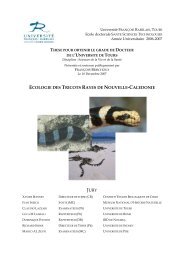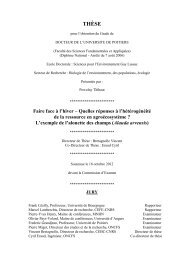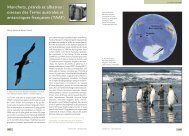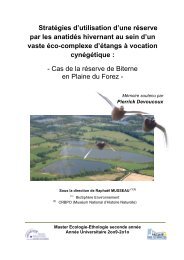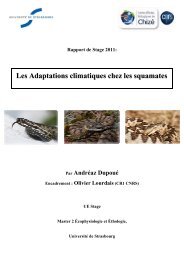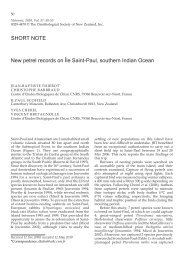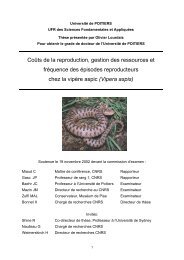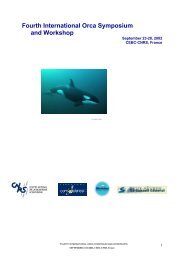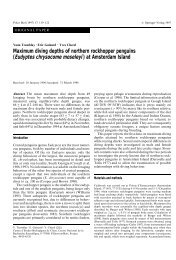Forçage environnemental et prédateurs marins ... - Cebc - CNRS
Forçage environnemental et prédateurs marins ... - Cebc - CNRS
Forçage environnemental et prédateurs marins ... - Cebc - CNRS
You also want an ePaper? Increase the reach of your titles
YUMPU automatically turns print PDFs into web optimized ePapers that Google loves.
1464 C. Barbraud <strong>et</strong> al.<br />
Fig. 2. White-chinned p<strong>et</strong>rel adult survival at Possession Island as a<br />
function of SOI −3. Regression line is estimated from a statistical<br />
model on a logit scale, and point estimates are with full variation over<br />
time. Error bars indicate SE.<br />
that individuals captured in year t were more likely to be<br />
captured in year t + 1 than those not captured in year t.<br />
Following Lebr<strong>et</strong>on <strong>et</strong> al. (1992), we made use of the overdispersion<br />
factor (0 = 2·164).<br />
Model selection indicated that recapture probability was<br />
constant and recruitment time-dependent. As expected,<br />
fisheries covariates negatively affected recruitment probability<br />
in year t, but also in year t + 1 and t + 2 (Supplementary<br />
Material Table S2). Most important was the effect of the<br />
toothfish fishery with a lag of 1 year, which remained significant<br />
using a Bonferroni corrected P value, and which<br />
explained 53·2% of the variability in recruitment. The number<br />
of individuals killed also negatively affected the recruitment<br />
probability in year t + 1 and t + 2 (Supplementary Material<br />
Table S2), and this effect remained nearly significant after<br />
using the Bonferroni m<strong>et</strong>hod.<br />
POPULATION MODELLING<br />
The asymptotic properties of the matrix model with timevarying<br />
param<strong>et</strong>ers were used for the starting age distribution<br />
of the simulation model. With a juvenile survival of 0·393, the<br />
predicted λ over the study period was 0·907 ± 0·026, lower<br />
than 1 (z = 3·58, P < 0·001). True juvenile survival must be<br />
much higher since we did not take into account the probability<br />
of d<strong>et</strong>ecting r<strong>et</strong>urning birds and of permanent emigration,<br />
and only a small part of the entire population was monitored.<br />
The best fit to the observed λ was obtained for a value of<br />
juvenile survival of 0·7. The sensitivity analysis of λ to demographic<br />
param<strong>et</strong>ers showed that it is mainly sensitive to adult<br />
survival which showed the most important contribution to<br />
the variance of λ (Supplementary Material Table S3).<br />
Incorporating the improvement in breeding success observed<br />
since 1995 in the population model and keeping other param<strong>et</strong>er<br />
values and their variance constant, achieved λ ≈ 1. Using<br />
the mean values of SOI, toothfish and hake fishing efforts<br />
during the last 3 years of the study achieved λ = 0·99,<br />
Fig. 3. Mean projected growth rate of the white-chinned p<strong>et</strong>rel<br />
population of Possession Island from a stochastic matrix model as a<br />
function of a change in (a) mean SOI −3, and (b) standard deviation of<br />
SOI −3. Plain line indicates the current effect of fisheries, dashed line a<br />
doubling of fishing effort of both toothfish and hake fisheries, and<br />
dotted line no effect of fisheries.<br />
indicating that the population is still declining at a slow rate of<br />
1% per year. The stochastic model indicated that the projected<br />
mean λ was strongly dependent both on variations in<br />
the mean and variability of SOI −3 and fisheries activities<br />
(Fig. 3). When fisheries are operating, λ is more sensitive to a<br />
decrease of the mean or to an increase of the variance of SOI −3.<br />
It is likely that if the fisheries continue to operate at current levels<br />
the population will probably not recover unless SOI −3<br />
increases importantly. If the fisheries continue to operate and<br />
SOI −3 decreases, it is likely that the population will decrease<br />
dramatically. A doubling of fishing efforts would strongly<br />
impact λ for decreasing, but not increasing, values of SOI −3.<br />
POTENTIAL EXCESS GROWTH<br />
Using the estimated average age at first breeding (6·1) and<br />
adult annual survival (0·895), we obtained λ max = 1·094. On<br />
Possession Island, burrows were only found on 5° to 30°<br />
veg<strong>et</strong>ated slopes at a maximum altitude of 200 m above sea<br />
level, and average density was 0·0714 breeding pairs 100 m –2 .<br />
The estimated surface area favourable for p<strong>et</strong>rels on the other<br />
© 2008 The Authors. Journal compilation © 2008 British Ecological Soci<strong>et</strong>y, Journal of Applied Ecology, 45, 1460–1467



